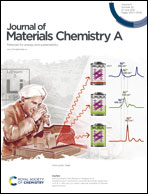A “turn-on” Cr3+ ion probe based on non-luminescent metal–organic framework-new strategy to prepare a recovery probe†
Abstract
Highly selective and sensitive, and low detection limit probes that can work in aqueous solutions are of great significance for detection. Presented here is a unique metal–organic framework of [Eu2L3(DMF)3]·2DMF·5H2O (1) that shows a luminescence recovery for the selective detection of Cr3+ ions in an aqueous solution with a calculated detection limit as low as 7.52 × 10−8 M. Both single-crystal to single-crystal characterization and Hirschfeld surface analysis revealed that 1 is pre-quenched due to self-absorption caused by the aggregation of aromatic groups between ligands. Only the binding of Cr3+ ions reduces the aggregation degree of ligand aromatic groups, which leads to a reduction in the self-absorption effect and ultimately causes the probe to show a turn-on response to Cr3+ ion. Furthermore, the probe can potentially find practical applications due to its recyclability, stability in aqueous solutions and convenience to prepare test strips for visual detection. This work not only develops a new strategy for the fabrication of pre-quenched MOF-based probes but also provides a new sensing mechanism. Thus, it gives a new insight into the development of MOF-based probes with excellent recovery response.



 Please wait while we load your content...
Please wait while we load your content...